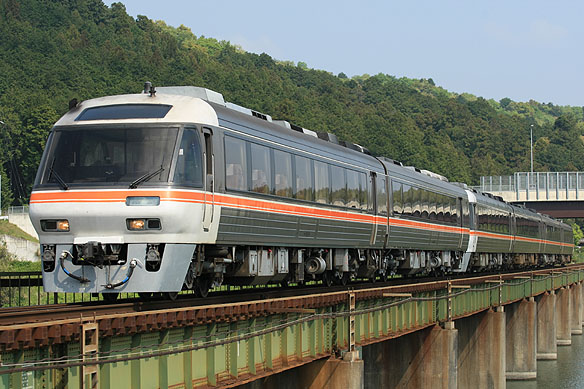Background and overview
JR Central developed Kiha85 series intercity diesel multiple unit (DMU) trains in order replace superannuated kiha82 series DMU used on "Hida" intercity services and delivered 8 vehicles in 1989.
Car body
They have 2930mm wide body, incorporating light weight stainless construction. Bodies are unpainted and have the orange and white waistline band running the length of each car below the windows. They also have the dark brown wide band around side windows. The end section of no gangwayed end vehicles is constructed by steel, featuring dogleg streamline shape, a wide windscreen, and a roof window to have a commanding view of the tracks ahead. The end section of gangwayed end vehicles is also constructed by steel, adopting dogleg streamline shape and a swing gangway door. Exhaust pipes of prime movers are fitted at the end plate outside to widen their passenger saloon as much as possible. They are equipped with a 760mm wide stepped single-leaf sliding door and the horizontal band fixed windows on each side of their body. Bronze coloured double-glazing tempered glass is employed for all windows. Traditional destination and seating classification rollsigns are fitted on the body. They employ two air conditioners, C-AU26, rated at 16,000kcal/h, of which indoor unit is fitted on their roof and of which outdoor unit is fitted under their floor and driven by their prime mover. Energy recovery ventilation units supply fresh air into the passenger room, instead of ventilators on the roof.
Bogies
Their bogies are C-DT57 featuring bolster-less air secondary suspension,
corn-shaped multilayered rubber spring journal supporting system, and the
Watts linkage draw gear. Motored bogies employ the double tread brake device.
Motored bogies feature 1-axle drive. Corrugated wheels are adopted for
the light weight and compound circular wheel profile are featured in order
to reduce lateral force against tracks.
Traction unit and ancillary equipments
JR Central researched domestic or foreign high-power engines to realize higher service speed and gradability for new generation DMU vehicles. As the result, JR Central decided to employ NTA855-R1 (350PS) of Cummins INC., US. JR Central classifies this engine into C-DMF14HZ. All kiha85 vehicles are equipped with two prime movers to realize that their maximum service speed is 120km/h and their balance speed is 100km/h at 20‰. Their hydraulic transmission gears are C-DW14A, featuring two-staged direct coupled range to realize maximum service speed at 120km/h and high gradability. The electric command brake with jake brake is employed for the first time among DMU vehicles in Japan.
Accommodation
All seats are adjustable reclining. 1st class vehicles have 2+2 abreast seating with 1160mm seating pitch and standard class vehicles have 2+2 abreast seating with 1000mm seating pitch. A partition wall behind the driver's cab is low and every seating is fitted on the high-level floor to provide sufficient passenger's view. A door between a vestibule and a passenger saloon is automatic, detecting by the photo sensor. A LED display for providing passenger information is fitted above the door between a vestibule and a passenger saloon. Class kiha85 vehicles are equipped with a Japanese style toilet and a washroom. Class kiroha84 vehicles are equipped with a Western style toilet and a washroom. Each toilet has a chemical holding tank. Class kiha84 are equipped with a catering room, a vending machine, and a public phone room. A conductor room is located in class kiroha84 vehicles.
Operations
They entered one return "Hida" intercity revenue service linking Nagoya and Toyama in February, 1989. JR Central continued to deliver 34 vehicles of kiha85 series DMU to replace remaining kiha82 series vehicles used on "Hida" intercity services
Additional delivery
JR Central delivered additional 24 vehicles of kiha85 series to replace superannuated kiha82 series used on "Nanki" intercity services subsequently in 1992. These vehicles differ from former kiha85 series vehicles in having some improvements.
No gangwayed first class end vehicles, class kiro85, were developed, having 2+1 abreast reclining seating with 1250mm seating pitch, a western toilet, a flushing urinal, and a washroom. Gangwayed end vehicles, kiha85-100, are equipped with an additional flushing urinal and classified into -200 subclass. Two types of intermediate vehicles, class kiha85, were also developed. Class kiha85-300 vehicles are not equipped with a catering room and a public phone room. Class kiha85-200 vehicles are equipped with a catering room which is useable as the simplified buffet, seating for disabled, and 1000mm wide doors for universal access. Every vehicle employs converter brake.
Modification
Kiha85 series vehicles employing high seating have low accessibility particularly to passengers using wheelchairs. In 2003, JR Central remodeled all class kiha85-100 vehicles to correspond to universal access transportation law enacted in 2000 and classified into -1100 subclass, removing 3 rows seats and 2 seats for disabled instead to enlarge the vestibule for the wheelchair to turn easily and to fit a universal access toilet and a universal access washroom. A class kiha85-200 was also remodeled in same way and classified into -1200 subclass.
Latest operation status
Kiha85 series are now used on "Hida" and "Nanki" intercity services. |
|





